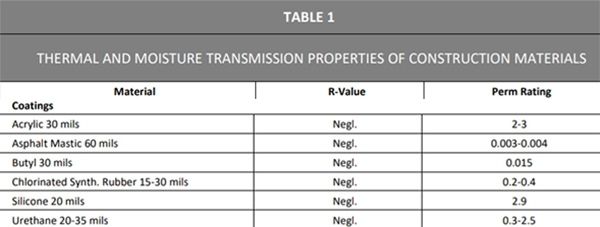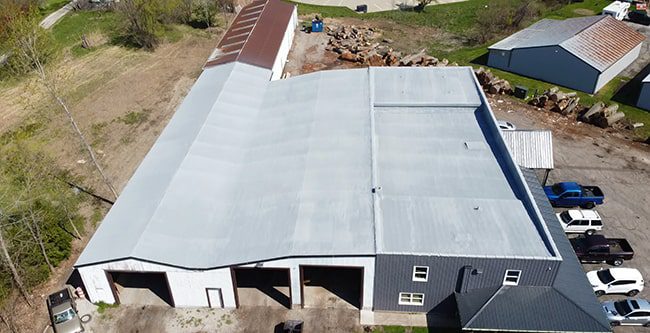A website visitor asked us, “What is the R-value of silicone roof coatings?”.
I replied, I think it’s pretty close to zero, but let me reach out to some of the top coating manufacturers and I’ll get back to you.
I reached out to Progressive Materials, they replied “There is not enough of an R-Value to put one down, but all materials have some amount of R-Value.”
I reached out to Carlisle Roof Foam & Coating, they replied: “Greg, here is a document about R-value and coatings from the SPFA Estimating Guide – available on the SPFA website.”
Here’s a snippet of that document that talks about R-value and coatings:

Now you may be wondering, if silicone roof coatings don’t increase R-value, then what purpose do they serve?
Before we get started, I wanted to mention that West Roofing Systems has been in the spray foam and coating business since 1979. We work with multiple manufacturers of roof coatings and are always in the loop on the latest formulations, issues, benefits, etc.
Let’s get started.
Why would someone want to install silicone coating on their existing roof?
There are many benefits to installing a silicone roof coating over your existing roof. Here are the top benefits:
Minimizes tear-off
On an existing roof that’s going to be coated, the contractor will only remove areas of the roof where the membrane is damaged or there’s saturated/wet insulation. This is cost-effective versus a complete tear-off where 100% of the existing roof is removed and replaced.
New warranty
Most silicone roof coating restorations come with a new 10, 15, or 20-year warranty. The warranty duration is influenced by the thickness of the coating that’s installed. Here are common thickness levels and the duration of the warranty:
- 10-year warranty = 20 mils of coating
- 15-year warranty = 25 mils of coating
- 20-year warranty = 30 mils of coating
Seamless
Silicone coating is fluid-applied, which means there are no seams. Seam failure is one of the most common causes of roof leaks.
Lower energy cost
Roof coatings can come in any color, but most choose a light grey or white. This is for maximum reflectivity of the sun. In most cases, changing the color of the membrane from black to white can result in 15-30% energy cost savings.
Renewability
The coating will naturally wear away on your roof. On a 20-year warranty, where 30 mils of coating would be installed, after 20 years, about 7-8 mils will remain. To renew your warranty, a contractor will bring the coating thickness to where it began. In this case, it’s 30 mils. Once that’s done, a new 20-year warranty would be granted. This is cost-effective versus traditional roofing systems because once their life expectancy has expired, they need to be completely torn off and replaced.
Now that we know the benefits of installing a silicone coating system, let’s take a look at why R-value on a roofing system matters.
Why does R-value on a roofing system matter?
R-value is a material’s ability to withstand the transfer of heat/cool air through it. The more R-value, the more heat/cool will stay in the building and not escape through the roof.
There are a few reasons why this is important.
Reason #1 – R-value influences your energy costs
The more R-value, the less your HVAC system has to work to maintain temperature. It’s no surprise that your energy bill is higher the more your HVAC system is working.
Reason #2 – You need to hit a certain R-value to comply with building codes
If you can restore your roof with coating, you don’t need to comply with building codes requiring a minimum R-value.
If you choose (or need) to perform a complete tear-off, your new roof will be considered “new construction” which requires a minimum R-value.
In Ohio, the minimum R-value for new construction is an R-25.
Now that you know a little bit about R-values, what options do you have if you need (or prefer) to increase the R-value of your roof?
How do you increase the R-value of your current roofing system?
If you have a traditional roofing system with insulation, you can remove the membrane and add more insulation.
Here’s the R-value of some of the most popular roofing insulations:
- Polyiso – R-value of 5.0 – 5.7 per inch of thickness
- EPS – R-value of 3.85 – 4.5 per inch of thickness
- XPS – R-value of 5.0 – 5.5 per inch of thickness
Another option is to install spray polyurethane foam over your existing roof.
Spray foam has an R-value of 6.5 per inch of thickness. Along with high R-value, there are other benefits to spray foam roofing, such as:
- Minimizes the tear-off of the existing roof
- Self-flashing
- Fully-adhered
- Renewable
- Seamless
- Easy to maintain

What should you do now?
I know this article talks about R-values and different roofing systems, but the best thing you can do now is to contact a roofing contractor.
Why?
If your roof is leaking, the cost to repair, restore, or replace it increases with every rainstorm.
And…contacting a roofing contractor gives you the ability to ask them what options you have.
Maybe the most cost-effective solution is a simple repair, maybe it’s a complete tear-off, or maybe it’s somewhere in-between?
But having someone look at your roof, do an inspection, pull a few core samples, etc. is the first step to getting your roofing problems solved.

